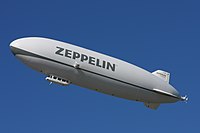
Photo from wikipedia
Abstract As the lighter-than-air (LTA) flight vehicle, the stratospheric airship is a desirable platform to provide communication and surveillance services. During the ascent from sea-level to the mission altitude, the… Click to show full abstract
Abstract As the lighter-than-air (LTA) flight vehicle, the stratospheric airship is a desirable platform to provide communication and surveillance services. During the ascent from sea-level to the mission altitude, the volume of the lifting gas may change significantly, which will result in the change of the center-of-buoyancy (CB). A general calculation method is developed to specify CB for the stratospheric airship with a double-ellipsoid hull and an arbitrary number of the gas cells. The cross-section-integral (CSI) method is used as a basic calculation scenario to specify CB. Considering the complexity in determining the boundary between the helium and air in the gas cell, a searching algorithm is put forward and the specification of CB can be conducted by the iterative calculation. As an important application, the stable condition of the pitch angle is analyzed when the change of CB is involved. Under different initial configurations, the stable pitch angle of the stratospheric airship during the ascent is specified and compared, which shows the advantages of the multi-gas-cell configuration. The results of this paper may provide an important reference for the engineering application of the stratospheric airship.
Journal Title: Advances in Space Research
Year Published: 2021
Link to full text (if available)
Share on Social Media: Sign Up to like & get
recommendations!